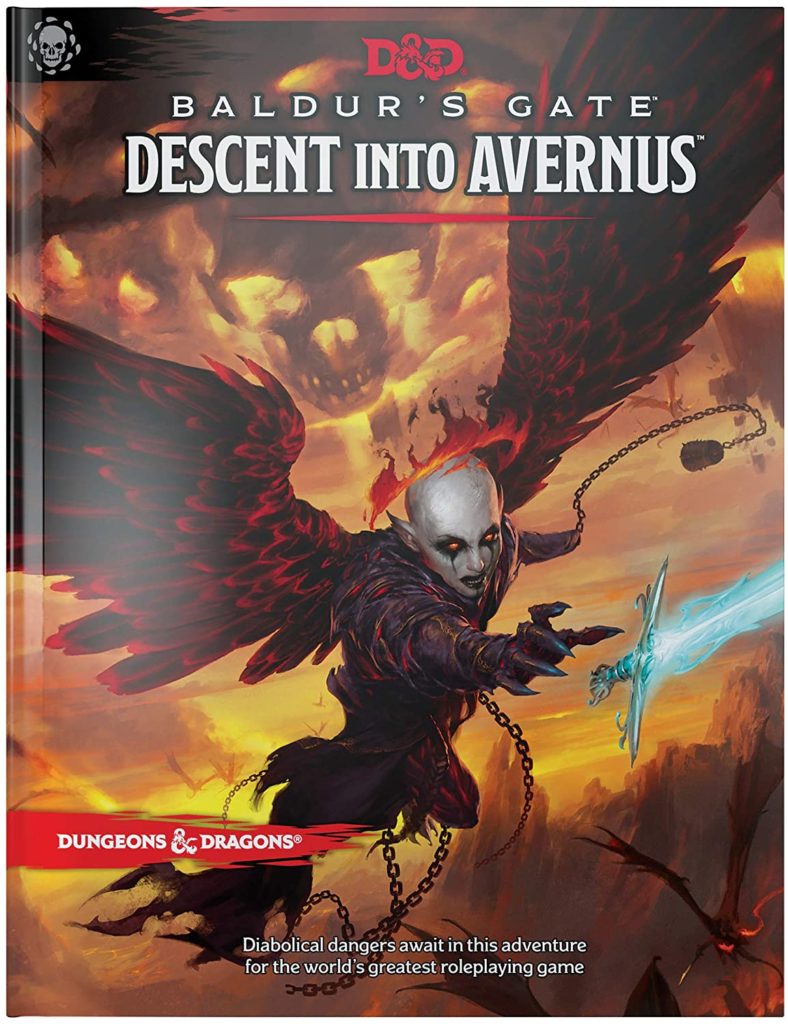Played: Descent into Avernus (DnD 5e)

Following the Played article about Storm King’s Thunder, we provide today a brief insight into our experiences with Descent Into Avernus for Dungeons and Dragons 5e.
In a good 30 sessions with about 4 hours of playtime, we dealt with a vanished city, a murdering cult, a conspiracy and finally the descent into hell itself in this adventure.
This post contains affiliate links, which are marked with a “*” in the name.
Spoiler Warning
Parts of the plot are revealed in this article. Just skip to the conclusion for a spoiler free take away.
Adventure Facts
Welcome to Baldur’s Gate, a city of ambition, corruption, and murder. You’ve just started your adventuring career, but already find yourself embroiled in a plot that sprawls from the shadows of Baldur’s Gate to the front lines of the Blood War!
Do you have what it takes to turn infernal war machines and nefarious contracts against the archdevil Zariel and her diabolic legions? Can you find your way home safely when pitted against the infinite evils of the Nine Hells?
A DUNGEONS & DRAGONS’ adventure for characters of levels 1 – 13. For use with the fifth edition Player’s Handbook, Monster Manual, and Dungeon Master’s Guide.
Text from the back of the book

- Publisher: Wizard of the Coast
- Release Date: 2019
- Language: English
- Pages: 256 (Adventure ca. 182)
- Format: Hardcover
- Price: 40 € on Amazon*
What awaits us in this adventure?
Advertised as Mad Max in Hell, this adventure begins in the name-giving city of Baldur’s Gate. The neighbouring city of Elturel has literally perished and many inhabitants who have not been swallowed flee to Baldur’s Gate. They fail at the gates and the Flaming Fist, which ensures “order” in large parts of Baldur’s Gate. In addition, the player characters are thrown directly into the action and confronted with this flood of fleeing now homeless people. At the gates of the City of Blood, a more than questionable captain of the Flaming Fist tasks the player characters. After that the group is to get on the trail of a murdering cult.
The player characters are slowly getting to the bottom of a conspiracy in Elturel, but also Baldur’s Gate. Zariel, archdevil of Avernus, was supposed to receive the city of Elturel as a reward for a diabolical pact and has dragged it into hell. To prevent this happening to Baldur’s Gate, the player characters are teleported to Hell. During their trip they can also choose to free the city of Elturel. However, to save Elturel, they must look for a way to stop Zariel in Avernus, for example by confront her with her own divinity.
A little Hollyphant is supposed to help them but suffers from memory loss. In consequence the motley crew has to find her missing memories in hell. There they encounter warlords and their infernal war machines, demon lords, devils of every rank, death knights and the blood war in general. Basically everything that is above their pay grade.
Short Chapter Overview
In the first chapter, which covers Baldur’s Gate and levels 1 – 5, there are three massive dungeons, if I leave out taverns and bathhouse and see mansion and cellar separately. By massive I mean 18+ rooms, now and then in good DnD mania practically empty. A good third to half of our total play time took place in the first chapter. Except for the “downtime” in the city, the chapter was a big dungeon crawl.
Elturel in the second chapter is more or less the approach to two places with a dungeon crawl. Here we learn in the high hall that we have to go to the graveyard (and then back again).
In the third chapter of the adventure, the “sandbox” actually begins. The characters can get a hell machine and set off on their journeys. Similar to Storm King’s Thunder, we have small sections with events as location descriptions. The only problem here is that these location descriptions with events are also the story.
There is the path of the demons and the path of the devils with 8 locations each. These paths are supposed to take the player characters on the way to the bloody citadel, the whereabouts of Zariel’s last spark of divinity. So instead of sandbox, here we experience the question: Do they want to board the train with demons or devils? Each location is described in a good 1-2 pages and leads piece by piece to new memories of our sacred companion. The downside of this is that a lot of work is required from the game master here. In addition, the story also feels more like a suicidal road trip.
In the fourth chapter the group is nearing and entering the bloody citadel. On the other hand, this chapter heralds the end of the campaign. The path to the true citadel is a dungeon crawl full of demons. The citadel contains a seven-part event in a dream afterwards.
The good Pages
Descent Into Avernus tells an epic story and the background of Elturel from Tyranny of Dragons* is explained in more detail here. Descent Into Hell sets up a monumental war of good versus evil, chaos versus order. Baldur’s Gate is described in a good 60 pages and offers a lot of information about the city outside the campaign. In the first part of the adventure (chapter 1), the story takes place in Baldur’s Gate. Therefore this directly allows the use of all the additional material in the back of the book.
Further helpful pages can be found in the appendix. There you will find more detailed explanations of the devil’s pacts, which play a central role in this adventure. Additionally, you also have a rich bestiary and devilish items, as well as the Mad Max-like war machines, at your disposal. Because the landscape of Avernus changes permanently, the random-based journey through dice results is also thematically appropriate.
The fifth chapter offers several endings of different kinds and approaches. This is where the creativity of the players is called for. In the endgame of the campaign, there is something for many tastes, from diplomacy to assassination and from devil’s pact to the epic battle. In our case, we tried and succeeded in the diplomatic route, which allowed the chapter to end in a good 1.5 hours.
The beautiful maps make this campaign super to play in Roll20 and the book again features high quality illustrations.
The bad Pages
Where Storm King’s Thunder* provided a helpful flow chart for different paths and possibilities, Descent Into Avernus offers several straightforward flows and thus serves merely as a sectional overview.
In good Wizard of the Coast style, information is difficult to find throughout the book and is scattered in text blocks.
Descent Into Avernus is a scavenger hunt in the true Railroad sense. It’s less about linear storytelling and more about chasing the story through dungeon crawls.
For whom is Descent Into Avernus?
The book is something for everyone who wants to get into Avernus and create an unforgettable ride through the levels of Avernus or needs information about Baldur’s Gate. Those who like dungeon crawls and rather tactical battles and have no expectations regarding dungeons will also find what they are looking for here.
Anyone who wants to do social role-playing should be prepared for work to expand and prepare the contents of this book, which is a good 206 pages long. After that though, the framework offers good potential to be a memorable campaign in Avernus and in the middle of the Blood War.
Conclusion
Descent into Avernus* promises epic conflict and infernal hell machines and delivers. For the price of the adventure, I was not willing to invest the work that would make this work something great. Too many corners needed to be polished here. The dungeons are boring to say the least. In addition, a table for cursed souls in Avernus could have captured much more of the flair of Dante’s Inferno.
The journey could also have done with a hexcrawl much more to allow the characters to take their own path, instead of randomly getting to a location. The paths send the characters down a road they have to walk along and they can look right and left, but don’t have much freedom. Storm King’s Thunder* handled this better as a comparison. There is a lack of random encounters for the journey. Additionally, a web of relationships for the core characters would have been helpful.
All in all, we had fun, but it was more because of the group, the characters and not the story. The story was ok-ish. Our group’s motivation was more about escaping hell and preventing something similar from happening to their hometown of Baldur’s Gate. I also don’t think it’s a good idea unless you play stupid lawful or chaotic characters. I can’t think of another motivation that makes you want to linger longer in hell. The implausibility of the story is increased when an Archmage sends the just common and still weak adventurers to Hell to change the fate of a city. The level of suspension of disbelief was also exceptionally high among the players.
Tips and additions
- Run Elturel as a Point-Crawl, to make the city, which is currently being dragged into hell, feel more alive.
- The missing Encounters in Avernus can be upgraded well with the Encounters in Avernus* supplement. We particularly played the side quest about Tiamat.
- With the motivation of our characters, the path of the demons or devils would not have been a choice. The characters did not trust either of the fiends one bit. Here the Path of the Hellriders was created, which was a combination of both paths and thematised the history of the Hellriders. The idea was outlined by Michael Shea and was modified even more in our case. As an example it was necessary to have an ally, such as Tiamat or Bel, to distract Zariel while reaching the bloody citadel.
- Play through hell with corruption! On p. 64 of the DMG, Pervasive Evil is explained. We supplemented this as follows:
- DC 10 Wisdom Saving Throw after each long rest.
- Failure leads to a level of corruption.
- A level of corruption is explained by a mental or physical change by the player (for example the willingness to help diminishes and one becomes more selfish).
- At 6 levels of corruption, one is permanently lawful evil.
- Good deeds allow an advantage on the saving throw, bad deeds a disadvantage (rarely used).






